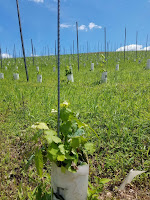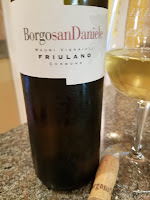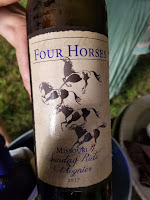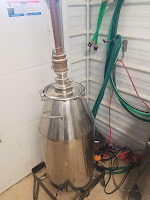"Natural Wine is farmed organically (biodynamically, using permaculture or the like) and made (or rather transformed) without adding or removing anything in the cellar. No additives or processing aids are used, and ‘intervention’ in the naturally occurring fermentation process is kept to a minimum. As such neither fining nor (tight) filtration are used. The result is a living wine – wholesome and full of naturally occurring microbiology." -- Raw Wine
 On June 22nd, Maryland's Old Westminster Winery hosted the inaugural Summer Solstice Festival featuring natural wines from across the globe. The event was held at the winery's Burnt Hill Farm which is their second vineyard but the first farmed using biodynamic practices. Once mature, the harvested grapes will be processed with little or no intervention in the cellar and Old Westminster will produce Maryland's first natural wines.
On June 22nd, Maryland's Old Westminster Winery hosted the inaugural Summer Solstice Festival featuring natural wines from across the globe. The event was held at the winery's Burnt Hill Farm which is their second vineyard but the first farmed using biodynamic practices. Once mature, the harvested grapes will be processed with little or no intervention in the cellar and Old Westminster will produce Maryland's first natural wines.
 But what is Natural Wine? When asked, representatives at the festival provided multiple definitions starting with either organically or biodynamically farmed grapes and finishing with various levels of winemaking intervention. Some stressed the importance of using zero sulfites which are used as a preservative and stabilizer. Others believe that a minimal amount of sulfites are allowable right before bottling but not during other stages of the winemaking process. Most representatives stressed the use of native yeast although some were inoculated with yeast cultures. Many of the natural wines were cloudy as a result of non-filtering whereas others were clean which suggest the use of a clarifying agent such as egg whites or isinglass (made from fish bladders).
But what is Natural Wine? When asked, representatives at the festival provided multiple definitions starting with either organically or biodynamically farmed grapes and finishing with various levels of winemaking intervention. Some stressed the importance of using zero sulfites which are used as a preservative and stabilizer. Others believe that a minimal amount of sulfites are allowable right before bottling but not during other stages of the winemaking process. Most representatives stressed the use of native yeast although some were inoculated with yeast cultures. Many of the natural wines were cloudy as a result of non-filtering whereas others were clean which suggest the use of a clarifying agent such as egg whites or isinglass (made from fish bladders).
As a result of these various practices, the wines were quite diverse ranging from cloudy and funky to clean and very traditional. I tended to prefer the latter as I felt the funkier styles provided excuses for traditional winemaking faults such as volatile acidity and reduction. These "faults" are counter-intuitive in the same wine since reduced winemaking is a method to prevent volatile acidity by reducing the amount of oxygen available for bacteria to create acetic acid. However, in some cases, the reduced notes did not blow off after swirling and remained in tandem with the vinegar notes. In other wines where the effects of reduction did blow off, the funkiness sometimes overwhelmed the fruit flavors. But in the natural wine world, when the fruit and funk mingle more gracefully, the wines are greeted with acclaim.
 During a pre-festival #WineStudio Twitter tasting that ran through June, we sampled the contrasting styles with the Old Westminster 2017 Home Vineyard Cabernet Franc and their 2018 Heirloom. Whereas both were bottled unfined and unfiltered the Cab Franc provided a more traditional profile full of fruit flavors with balanced tannins and acidity. I wish more East Coast wineries could replicate this excellent wine. On the other hand, the 77% Chardonnay, 12% Albarino, and 11% Muscat blend in the Heirloom was funkier in style perhaps from fermenting with native yeast and took quite a few sips to comprehend. I am well acclimated with this style in cider and beer - but not so much with wine.
During a pre-festival #WineStudio Twitter tasting that ran through June, we sampled the contrasting styles with the Old Westminster 2017 Home Vineyard Cabernet Franc and their 2018 Heirloom. Whereas both were bottled unfined and unfiltered the Cab Franc provided a more traditional profile full of fruit flavors with balanced tannins and acidity. I wish more East Coast wineries could replicate this excellent wine. On the other hand, the 77% Chardonnay, 12% Albarino, and 11% Muscat blend in the Heirloom was funkier in style perhaps from fermenting with native yeast and took quite a few sips to comprehend. I am well acclimated with this style in cider and beer - but not so much with wine. So quite naturally at the Summer Solstice, I drifted towards the more traditional wines starting with Oregon's Brooks Winery. The Estate Vineyard for this Williamette Valley winery was certified by Demeter for Biodynamic farming principles in 2012. And in the cellar, they utilize low intervention winemaking practices but release very clean and traditional wines as evident by the Pinot Gris, Riesling, and Pinot Noir. These wines are delicious and represent the grape profiles perfectly. Brooks also provides an original profile indicator on their website which displays color-coded bar charts representing aroma and flavor.
So quite naturally at the Summer Solstice, I drifted towards the more traditional wines starting with Oregon's Brooks Winery. The Estate Vineyard for this Williamette Valley winery was certified by Demeter for Biodynamic farming principles in 2012. And in the cellar, they utilize low intervention winemaking practices but release very clean and traditional wines as evident by the Pinot Gris, Riesling, and Pinot Noir. These wines are delicious and represent the grape profiles perfectly. Brooks also provides an original profile indicator on their website which displays color-coded bar charts representing aroma and flavor. Nearby, the Georgian Wine House was pouring similarly delicious wines from this ancient country located in the Caucasus region of Eurasia. The Georgian winemaking tradition is known for using qvevri vessels to ferment and age the wine. If a white wine is aged with prolonged skin contact then the resulting wine becomes light orange in color with more depth in flavor. Naotari Winery specializes in this technique and the family operation (Koba Kvatchrelishvili and his two sons, Rezo and Alex) releases the Khikhvi Blend 2016 natural wine. This blend of Rkatsiteli, Kisi, and Khikhvi is fermented with native yeast, is unfiltered, and undergoes zero intervention or added sulfite. Yet it is full of stone fruit aromas and flavors with no traces of volatile acidy or reduction.
Nearby, the Georgian Wine House was pouring similarly delicious wines from this ancient country located in the Caucasus region of Eurasia. The Georgian winemaking tradition is known for using qvevri vessels to ferment and age the wine. If a white wine is aged with prolonged skin contact then the resulting wine becomes light orange in color with more depth in flavor. Naotari Winery specializes in this technique and the family operation (Koba Kvatchrelishvili and his two sons, Rezo and Alex) releases the Khikhvi Blend 2016 natural wine. This blend of Rkatsiteli, Kisi, and Khikhvi is fermented with native yeast, is unfiltered, and undergoes zero intervention or added sulfite. Yet it is full of stone fruit aromas and flavors with no traces of volatile acidy or reduction.
Similarly, Chona’s Marani Winery is another family venture producing natural wines like the Rkatsiteli 2017 and Mtsvane-Rkatsiteli Blend 2017. Pure, clean, and delicious wines. Finally, sisters Baia and Gvanca showed two excellent wines in the Baia's Wine and Gvanca's Wine with Baia focusing on white wine and Gvanca red. The Gvanca's Wine Otskhanuri Sapere 2017 exudes sour cherries and not in a funky way. The Baia's Wine Tsolikouri 2018 is also fermented with wild yeast, unfiltered, and uses very low levels of sulfites that provides clean citrus and apple flavors with refreshing acidity.
 Traveling towards the Mediterranean there was another brilliant natural wine from Turkey imported by Siema Wines. Mustafa Çamlica founded Chamlija Winery in "2000 in the small Thracian town of Büyükkarıştıran, and planted his vineyards throughout the decomposed granite soils of the Strandja Massif, near where Turkey meets Bulgaria". At the festival, Siema poured this winery's Papaskarasi Rosé - a rare indigenous Turkish grape variety. This delicate wine provides a soft texture to its strawberry profile finishing with refreshing clean acids. And the distinct label was drawn by Çamlica's daughter Irem - a renowned artist in Turkey.
Traveling towards the Mediterranean there was another brilliant natural wine from Turkey imported by Siema Wines. Mustafa Çamlica founded Chamlija Winery in "2000 in the small Thracian town of Büyükkarıştıran, and planted his vineyards throughout the decomposed granite soils of the Strandja Massif, near where Turkey meets Bulgaria". At the festival, Siema poured this winery's Papaskarasi Rosé - a rare indigenous Turkish grape variety. This delicate wine provides a soft texture to its strawberry profile finishing with refreshing clean acids. And the distinct label was drawn by Çamlica's daughter Irem - a renowned artist in Turkey.
Siema poured another clean and textured wine, this time from the Friuli region of Italy. Borgo San Daniele is operated by the brother and sister team of Mauro and Alessandra who do not use chemical products in their vineyard and minimalistic techniques during vinification. Their Mauri Vignaioli Friulano (formerly called Tocai Friulano) is complex with a soft fruit and almond profile and finishing with elegance.
So cheers to these clean and fresh natural wines and Old Westminster Winery for hosting a fantastic event.











































